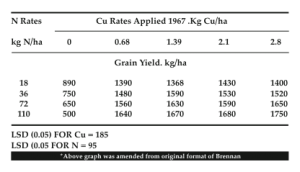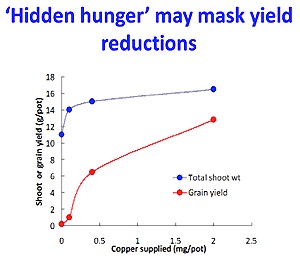Micro Nutrients, although only needed in small amounts are critical to the development of plants. Needed for: germination and emergence; Photosynthesis; production of the root and shoot partitioning; reproductive development; flowering; pollination; grain set, grain fill; protein as well as assisting in tolerance to stress from drought, heat, frost and disease.
Copper is one element often forgotten but plays a role in all of the above. The following outlines benefits of copper, factors affecting availability and explains how some of these factors can affect quality and quantity in broad acre cereals.
Copper is essential for many plant functions. Some of them are
- Pollination & seed set
- Carbohydrate and protein metabolism.
- Formation of lignin in plant cell walls which contributes to the structural strength of the cells, and the plant.
- A catalyst in photosynthesis and respiration.
- It is a constituent of several enzyme systems involved in building and converting amino acids to proteins.
Factors Affecting Availability
- Root Growth: Copper is the most immobile micronutrient, therefore anything that inhibits new root growth will inhibit Cu uptake including chemical pruning and root disease.
- Soil pH: Acid soils increase Cu uptake and High pH inhibits uptake.
- Organic Matter: Copper is readily and tightly complexed by organic matter, therefore high soil organic matter levels reduce Cu availability.
- Flooding: Waterlogged soils can reduce Cu availability while they are saturated, however after they are drained the Cu will become available again. .
- Cu:P Balance: High soil and plant P levels can reduce Cu uptake due to reduced soil exploration by mycorrhizas associated with plant roots.
- N Stress: Low N availability decreases the vigor of plants to an extent that it may fail to take up adequate amounts of many other nutrients. Copper uptake can be affected in this way.
- Cu:N Balance: High N uptake in the presence of marginal Cu levels can lead to a reduction of Cu transport into the growing tips of plants.
The Cu:N balance is a major concern in the modern high N input system. The following trial is taken from the book “principals of plant nutrition”. This depressive effect of N fertiliser on grain yield of wheat under copper deficiency conditions is shown in the table below from the work of Brennan (1994) these field trials were carried out in WA on a gravelly sandy soil low in available copper however field demonstrations throughout Australia are showing similar results.

As stated in the graph the higher the nitrogen rate applied and the lower the Copper rate applied can have a significant effect on yield, demonstrating the importance of copper levels in the soil and plant.
The next critical component to understand the makeup of a plant and when copper is concerned it is important to understand what Lignin is. Lignin is an organic substance binding the cells, fibres and vessels which constitute wood and the lignified elements of plants, as in straw.
Weakened lignification of cell walls is the most typical change induced by copper deficiency in plants. This gives the characteristic of distortion of young leaves, bending and twisting of stems and an increase in the lodging susceptibility of cereals, particularly in combination with a high nitrogen supply. The inhibition of lignification (which leads to lodging) is related to the direct roles of two copper enzymes in lignin biosynthesis. In lowered lignification scenarios, phenolic compounds can accumulate, resulting in melanosis (brown pigmentation) in wheat
The next critical component is protein synthesis. Copper is an important component of proteins found in the enzymes that regulate the rate of many biochemical reactions in plants. Plants would not grow without the presence of these specific enzymes. Low levels of copper in the plant are delivering lower protein grain and hay effecting quality of the product we deliver.
 The importance of these different functions and their dependence on plentiful levels of copper help to illustrate the important role, which copper plays in the overall health of plants. However it is quite often noted that there is not enough copper available in the soil for the plant to take up. Copper is very immobile in the soil and with other constraints mentioned above it is becoming more and more apparent that plants are not taking up enough copper. As a result we are seeing more and more copper deficient symptoms but there is also hidden hunger masking yields and quality. The graph below taken from “Glenn McDonald from the School of Agriculture, Food and Wine Waite Campus slides” shows the effect of hidden hunger on both biomass and grain yields.
The importance of these different functions and their dependence on plentiful levels of copper help to illustrate the important role, which copper plays in the overall health of plants. However it is quite often noted that there is not enough copper available in the soil for the plant to take up. Copper is very immobile in the soil and with other constraints mentioned above it is becoming more and more apparent that plants are not taking up enough copper. As a result we are seeing more and more copper deficient symptoms but there is also hidden hunger masking yields and quality. The graph below taken from “Glenn McDonald from the School of Agriculture, Food and Wine Waite Campus slides” shows the effect of hidden hunger on both biomass and grain yields.
In the simplest of terms, what this means is that if growers are aiming for high yields in cereal crops, they should pay close attention to soil and plant available copper levels to avoid yield loss, quality loss, delayed maturity and severe crop lodging, primarily as a consequence of copper deficiency induced by high nitrogen levels as discussed above.
So what do we do about our copper levels?? Foliar and/or soil application of copper may be necessary to increase straw strength and maximise production. The window of opportunity to correct a copper deficiency lasts until just before head emergence however in hay crops and grain crops we are finding early suspension concentrate foliar applications are helping to prevent lodging and increase protein and grain yields. It has been discovered that more than one application may be required for best results. Visual symptoms are a sign that should be verified by a tissue test. Small amounts of copper applied at the correct timing can have a huge influence on yield and stability of the crop.
